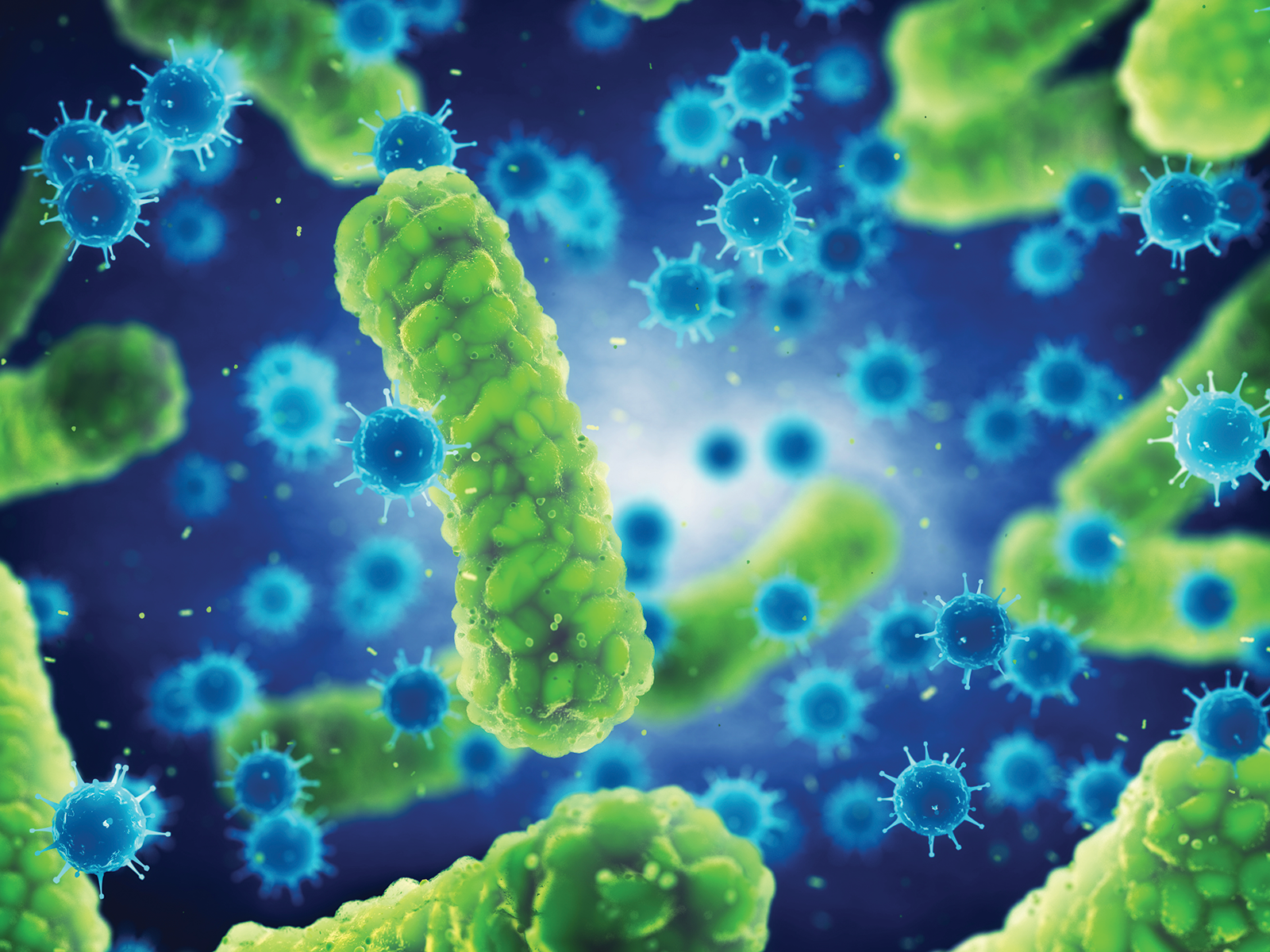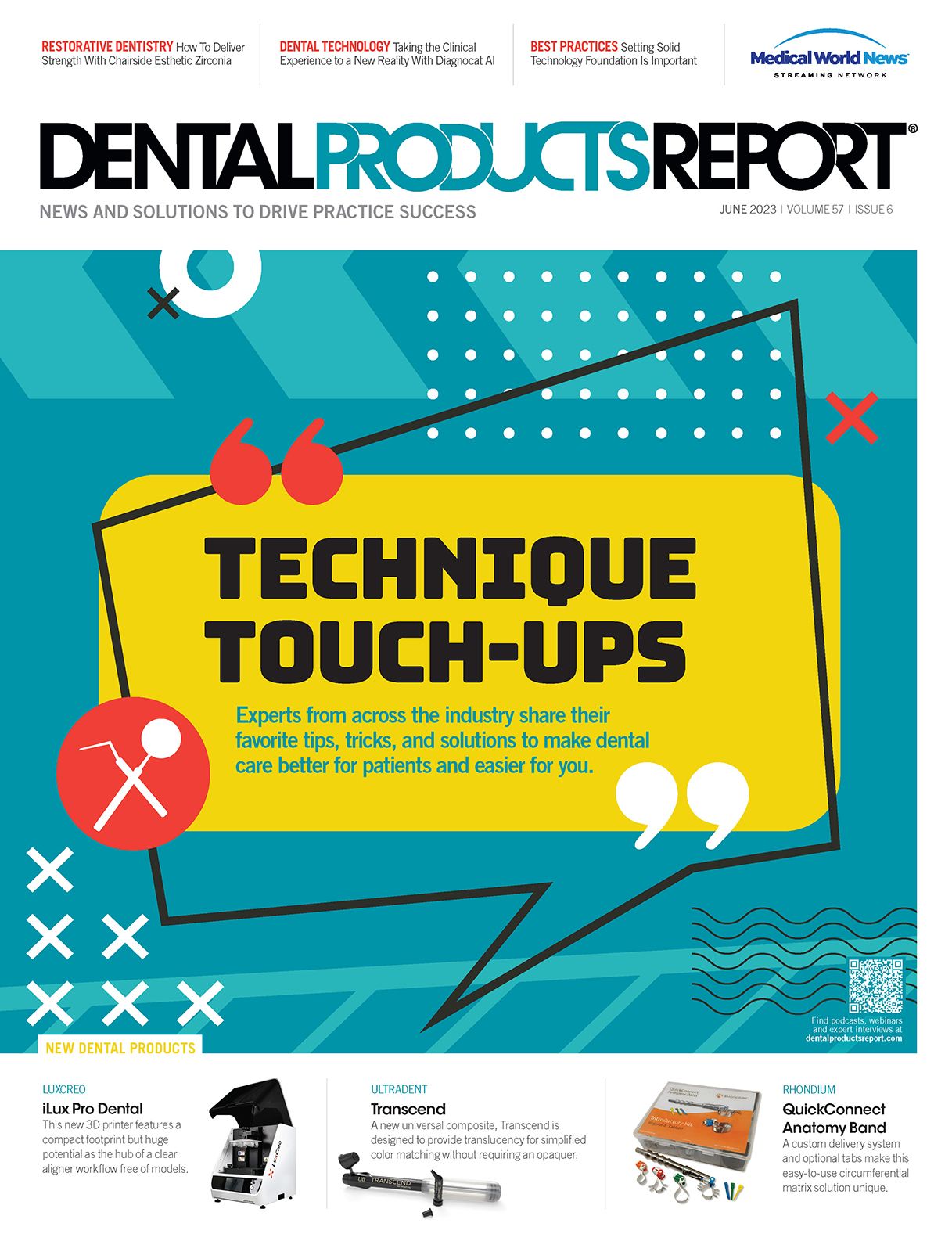Understanding Antimicrobial Dental Materials
As dental materials with antimicrobial properties become more common it’s important to be educated about how they work and the benefits and risks they can provide patients.
Image Credit: © nobeastsofierce / stock.adobe.com

The longevity of dental restorations has long been a concern for dentists and patients alike. And it should be: research shows that more than half of US restorations each year are performed to replace those that have failed1 primarily due to the bacteria that causes secondary caries.2,3
Common culprits like Streptococcus mutans and Lactobacillus casei thrive in acidic environments and can quickly result in infection and restoration failure. Fortunately, antimicrobial substances have been incorporated into smart biomaterials to reduce the formation of the biofilm where bacteria flourish.
“Antimicrobial restorative materials can be…put on tooth preparations to address any remaining bacteria or [on] filling materials that prevent the attachment of bacterial plaque,” says Nathaniel Lawson, DMD, PhD, director of the Division of Biomaterials at the University of Alabama at Birmingham School of Dentistry. “The second application, an antibacterial filling material, is the newer concept.”
Triggered by internal and external stimuli, these substances deliver on-demand care and have surpassed antibiotics in popularity because their toxicity is lower, their shelf life longer, they cause less environmental harm, and offer superior control, location selection, and dosing options, thus reducing the risk of antibiotic resistance.4
Agents
Although their goal is the same, these agents come in different varieties. According to Dr Lawson, “there are antimicrobial preventative materials, like those used in mouth rinses,” including “0.12% chlorhexidine, essential oils, and CPC [Cetylpyridinium chloride],” and others that “can be applied on tooth preparations…such as 2% chlorhexidine, silver diamine fluoride, GLUMA, or liners [calcium hydroxide and calcium silicate]…[and] a new antimicrobial composite [that] contains a quaternary ammonium compound.”
Antimicrobial agents can be classified into 3 categories: polymeric biocides, biocidal polymers, and biocide-releasing polymers. Polymeric biocides consist of amino, hydroxyl, or carboxyl units that are bound to a polymer backbone. They repel microbes and thus prevent their adhesion. Biocidal polymers contain cationic moieties (like quaternary ammonium compounds [QACs], phosphonium, guanidinium, and tertiary sulfonium) that kill microbes. Biocide-releasing polymers, as their name implies, discharge molecules into the oral microbiome that kill bacteria over time.5
As Dr Lawson observes, many of these agents are added to preventative materials like chitosan, triclosan, polyquaternary ammonium salts, quaternary ammonium dimethacrylate, and furanone. More frequently, however, silver nanoparticle (NAg), 12-methacryloyloxydo-decylpyridinium bromide (MDPB), chlorhexidine digluconate (CHX), and QACs are used in them.
The efficacy of NAg, researchers say, stems from its ability to deactivate bacterial enzymes and alter the replication mechanism of bacterial DNA,6,7 whereas MDPB damages the cytoplasmic membrane of bacteria. MDPB was first used in CLEARFIL™ SE Protect (Kuraray Dental) and is now ubiquitous.
CHX kills cells by obstructing their membrane transport systems and causing their intracellular material to leak, thus preventing bacterial formation and reducing plaque accumulation around restorations. Commonly used in such mouthwash as 3M™ Peridex™ (chlorhexidine gluconate 0.12%) and in antibacterial solutions like Consepsis™ (2% chlorhexidine) from Ultradent, CHX is likewise found in numerous products outside the operatory.
QACs are said to be one of the most effective disinfectants in resin nanocomposites. Used as monomers or micro/nanofillers, they have 1 or more methacrylate functional groups. Those with longer chain links have higher antimicrobial activity. QACs have low cytotoxicity and offer strong long-term antimicrobial benefits without leaching.8
One product making waves is Infinix™ from Nobio, the first FDA-cleared restorative material to contain nonreleasing, nonleaching QACs. These particles attract bacteria electrostatically and reduce enamel demineralization and secondary caries by 68%.
The Infinix product line includes both a universal and a flowable composite and a universal bonding system with primer and bond, all of which incorporate nonleaching, nonsoluble QACs.
Delivery
There are 2 ways to deliver antimicrobials. The first is contact-killing and takes place at the treatment stage via disinfectants or etchants. The second is antimicrobial agent release, which involves inserting a leachable, polymerizable, or filler particle into a dental adhesive or resin and works over time.9
Killing on contact
Contact-killing agents are immobilized within the polymer structure and able to deliver long-lasting benefits without leaching. They prevent the growth of numerous pathogens known to cause caries, periodontal disease, and endodontic infection. These nonleaching materials reduce biofilm and microbial adhesion through physisorption and/or covalent conjugation.10 However, they are ineffective against planktonic bacteria and subject to biofouling, whereby they absorb dead bacterial cells and lose potency.11
Agent release
This approach allows not only for delivery of antimicrobial agents to a specific site, reducing the potential for antimicrobial resistance caused by less targeted approaches, but also for continued release of embedded compounds that kill bacteria over time. However, the rate and longevity of release are difficult to establish. Because the concentration of antimicrobial agents is low, their efficacy is reduced. NAg particles are the most commonly released antimicrobials, owing to their high biocompatibility and low toxicity.10
Multifunctional strategies
These strategies are being developed to address the drawbacks of the other approaches. Antimicrobials that can be activated and function in different ways are more efficacious. Silver, for instance, has antibacterial, antiviral, and antifungal properties, its release is easy to control, and its long-term effect easy to sustain.8 NAg has also been combined with Quaternary ammonium methacrylates [QAMs] to kill bacteria on the material’s surface and away from it.
Contact-killing and chemical-releasing approaches employ bioactive, bioresponsive antimicrobials. Bioactives with metallic and nonmetallic fillers, CHX, other cationic monomers, including MDPB, and other QACs are incorporated into a carrier like a resin, filler, or coating, to deliver antimicrobials that work on contact and sometimes also have time-release capabilities.12
Bioresponsive therapies offer long-term benefits. Once activated—by light, electrical or magnetic stimuli, pH changes, and bacterial or salivary enzymes—the biomaterial in the carrier (be it a resin, an adhesive, sealant, or nanocarrier) releases antimicrobials.12
A third option, still under development, is an autonomous biomaterial that can respond to different stimulus and adapt itself to address them—essentially, the compound is completely integrated into the natural biological system.12
Carriers
Resins
Dental resins (composites, adhesives, and primers) are common vehicles for bioactive monomers,13 which can be linked inside the polymer chain or act as a leachable compound, both unpolymerized and polymerized.12 Antimicrobials in resins are effective against a wide range of gram-positive and gram-negative pathogens.12
Biofilm-related infections have risen in tandem with the proliferation of resin-based materials.10 The rate of secondary infections with these materials have reached around 60%, making the integration of antimicrobial agents into resins a priority.
One study evaluating the efficacy against S mutans of quaternary ammonium polyethyleneimine (PEI) nanoparticles in resins discovered that these nanoparticles had contact-killing effects that also lasted for at least 1 month. Using a scanning electron microscope, the researchers also determined that no streptococcal chains remained within 24 hours of contact.14
Fillers
Because bioactive fillers are generally inorganic—most commonly made using zinc oxide, silver, titanium, diamond, glass, or polymeric compounds like quaternary ammonium PEI—they don’t contribute to antibiotic resistance and can be designed to target specific pathogens.12
Coatings
Antimicrobial coatings have been found to reduce peri-implant mucositis, implantitis, and implant failure by preventing biofilm formation and bacterial growth on the surfaces of implants.12 Coatings kill on contact with agents like QACs and enzymes. Although coating placement helps reduce the amount of antibacterial needed, in some instances the coating’s antimicrobial properties can compromise implant biocompatibility and osseointegration.12
Challenges
Given the threat of antimicrobial resistance, the long-term release of antimicrobials could be disadvantageous. Because release begins immediately upon placement, treatment duration is often limited, and little is known about long-term effects. One study found that on average, the effects of a leachable agent lasted less than 1 year and, once depleted, could not be recharged.15
In addition to agent longevity, concerns have been raised about appropriate doses. Because their release is uncontrolled, antimicrobials may deploy too quickly and become depleted before therapy is complete. Finally, the inability to target specific microbes can have repercussions on the oral biome, causing an imbalance between good and bad bacteria, like S mutans.
Despite the challenges, antimicrobials have improved dramatically over the past few decades, and researchers continue to make strides in terms of dose deployment, duration, and control. In the future, clinicians can expect to see strategies that address the drawbacks of agent-release and contact-killing methodologies and more effective ways to reduce biofilm and bacteria.
References
- Rupf S, Balkenhol M, Sahrhage TO, et al. Biofilm inhibition by an experimental dental resin composite containing octenidine dihydrochloride. Dent Mater. 2012;28:974-984. doi:10.1016/j.dental.2012.04.034
- Takahashi N, Nyvad B. Caries ecology revisited: microbial dynamics and the caries process. Caries Res. 2008;42(6):409-418. doi:10.1159/000159604
- Sakaguchi RL. Review of the current status and challenges for dental posterior restorative composites: clinical, chemistry, and physical behavior considerations. Dent Mater. 2005;21(1):3-6. doi:10.1016/j.dental.2004.10.008
- Chen L, Suh BI, Yang J. Antibacterial dental restorative materials: a review. Am J Dent. 2018;31(B)6B-11B.
- Ramburrun P, Pringle NA, Dube A, Adam RZ, D’Souza S, Aucamp M. Recent advances in the development of antimicrobial and antifouling biocompatible materials for dental applications. Materials. 2021;14(12):3167. doi:10.3390/ma14123167
- do Amaral GS, Negrini T, Maltz M, Arthur AR. Restorative materials containing antimicrobial agents: is there evidence for their antimicrobial and anticaries effects? A systematic review. Aust Dent J. 2015;61(1):6-15. doi:10.1111/adj.s12338
- Morones JR, Elechiguerra JL, Camacho A, et al. The bactericidal effect of silver nanoparticles. Nanotechnology. 2005;16(10):2346-2353. doi:10.1088/0957-4484/16/10/059
- Makvandi P, Jamaledin R, Jabbari M, Nikfarjam N, Borzacchiello A. Antibacterial quaternary ammonium compounds in dental materials: a systematic review. Dent Mater. 2018;34(6):851-867. doi:10.1016/j.dental.2018.03.014
- Jiao Y, Tay FR, Niu L, Chen J. Advancing antimicrobial strategies for managing oral biofilm infections. Int J Oral Sci. 2019;11(28).doi.org/10.1038/s41368-019-0062-1
- Mitwalli H, Alsahafi R, Balhaddad AA, Weir MD, Xu HHK, Melo MAS. Emerging contact-killing antibacterial strategies for developing anti-biofilm dental polymeric restorative materials. Bioengineering (Basel). 2020;7(3):83. doi:10.3390/bioengineering7030083
- Tiller JC, Liao CJ, Lewis K, Klibanov AM. Designing surfaces that kill bacteria on contact. Proc Natl Acad Sci USA. 2001;98(11):5981-5985. doi:10.1073/pnas.111143098
- Montoya C, Roldan L,Yu M, Valliani S, Ta C, Yang M, Orrego, S. Smart dental materials for antimicrobial applications. Bioact Mater. 2022;24:1-19. doi:10.1016/j.bioactmat.2022.12.002
- Imazato S, Chen J, Ma S, Izutani N, Li F. Antibacterial resin monomers based on quaternary ammonium and their benefits in restorative dentistry. Jpn Dent Sci Rev. 2012;48(2):115-125. doi.org/10.1016/j.jdsr.2012.02.003
- Beyth N, Yudovin-Farber I, Bahir R, Domb AJ, Weiss EI. Antibacterial activity of dental composites containing quaternary ammonium polyethylenimine nanoparticles against Streptococcus mutans. Biomaterials. 2006;27(21):3995-4002. doi:10.1016/j.biomaterials.2006.03.003
- Raszewski Z, Nowakowska D, Więckiewicz W, Nowakowska-Toporowska A. The effect of chlorhexidine disinfectant gels with anti-discoloration systems on color and mechanical properties of PMMA resin for dental applications. Polymers (Basel). 2021;13(11):1800. doi:10.3390/ polym13111800
